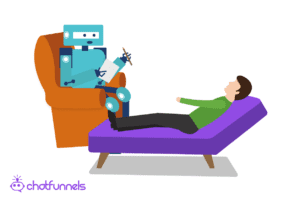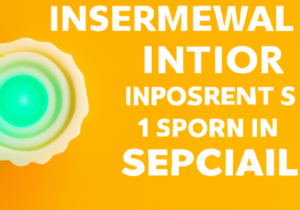We talk a lot about what to do when building a chatbot, but let’s discuss what not to do. Chatbot design and deployment can appear overwhelming. It may seem like there are an endless possibility of mistakes to be made. There are so many facets to chatbot-building techniques, so it is useful to know what the most common mistakes are. In a recent podcast with Billy Bateman featuring Rachel Batish, VP of product strategy at Audio Burst, they highlight three key points of what not to do when building a chatbot.
First off, you don’t need to think of chatbot building as something technical. Of course, it’s easy to get caught up in the technical aspects of the process, and if that’s your specialty, then dive right in! But for those whose strong suit isn’t technical, no need to worry. Just focus on the flow and make sure the chatbot does what it’s supposed to do. It’s all about having a conversation with the customer. Rachel brings up three common mistakes people make in the process of chatbot building. Avoid these three “no no’s” and your chatbots will be much more effective.
3 Mistakes People Make When Building a Chatbot
1. Don’t Botanize the Chatbot
Rachel coins the term “botanize,” which she explains basically means making it seem too much like an emotionless robot. The chatbot is replacing a human sales rep; it’s not replacing a web form. Web forms and chatbots are both used to get leads and help people convert, but in different ways.
Chatbots provide a much more enjoyable experience for the customer because it is just a friendly conversation. (However, there is still a place for forms, it’s just not within the chatbot.) Their purpose is to provide the customer with what they need to start down the road to conversion. And they do so by offering a comfortable experience. You should not simply take what’s already on your website and try to turn it into a chatbot. In fact, you should do quite the opposite! Take the script of what the sales rep would say and turn that into the chatbot’s copy.
You want to make your chatbot as life like as you can. It serves the purpose of a sales rep, while allowing the customer to avoid having to call in. Customers seem to be more comfortable with chatbots than with phone conversations. But undeniably, they are still more inclined to engage with a chatbot when it is conversational and casual, not robotic. So don’t make the mistake of having a disengaged, boring chatbot.
2. Don’t Leave Your Chatbot to Its Own Devices
It’s far too easy to deploy your chatbot and then completely forget about it. Don’t do that! That’s another one of the very common mistakes. Yes, your chatbot doesn’t necessarily need daily adjustments, but it does need to be iterated. Maintain your chatbots by revising them and testing to see what works best. That way you can improve it’s effectiveness.
Consider what to add, what to eliminate, what to change. Ask yourself, “Where are we losing people along the way? How could we change the flow to keep them engaged longer?” No chatbot is perfect right after deployment. It’s impossible to know exactly what will work best for your customers, but that’s okay. That’s why it is crucial to go back through and edit the chatbot. Run tests to see what works best.

And always keep the goal in mind. What is the specific goal of your chatbot? Is it to capture an email? Or get them to book a demo? Or is it simply to get the customer the information they need? Whatever the goal may be, always aim towards increasing the success rate of the chatbot in accomplishing what it’s meant to do. If you’re finding that your chatbot is not doing a great job at that, that’s where you need to make adjustments. Edit the copy, tweak the question order or wording, or maybe take out unneeded steps. Do whatever it takes to keep the customer engaged with the chatbot. Keep in mind that chatbots with low engagement may see 35-40% response rates, while better-designed chatbots can result in 80-90% response rates.
3. Don’t Overlook What Your Customers Need
The third mistake is that oftentimes the use case you had in mind has no real implications. Again, we can’t predict with 100% certainty how our customers will interact with the chatbot. We might think they will say one thing, and then come to find out they go in a completely different direction. Be ready to adapt. Stop thinking about what you think your customer needs, and instead go find out what your customer actually needs. We may get caught up in our own brilliant ideas and fail to realize that that’s not really what customers are looking for.

The customer needs to feel like the chatbot is really “listening” and understanding them. Most customers (56%) expect to find what they’re looking for from a company in 3 clicks or less. If they feel like the chatbot isn’t doing that for them, they become disengaged and frustrated. So, to avoid upsetting your customers, you really need to define your use cases. And it honestly shouldn’t be that hard. For example, if a chatbot is on a specific web page, you already have a pretty good idea of what the customer will be looking for or what assistance they might need. Make and edit the chatbot to give them the most pleasant experience on your website.
Just look at the facts- 83% of consumers said they would be more loyal to a brand who offers a chatbot for tasks like making an appointment or handling customer service inquiries. 83%! You want returning customers, right? Make sure your chatbot is functioning efficiently and effectively. Remember, figure out how your customers are interacting with the chatbot and build out your use cases to cater to their needs.
- Consider this: Is putting in a chatbot actually solving a pain point? Maybe a chatbot isn’t necessarily needed for that use case. Like we mentioned, it may be more realistic to use a web form for certain use cases and chatbots for others.
Conclusion
Overall, do what makes sense for your website and your customers. Chatbot building does not need to be a complex process, yet it can yield amazing results. 52% of consumers are more likely to make repeat purchases if the company offers support via live chat. Just don’t forget to avoid these 3 common mistakes to make the most out of your chatbot.
READ MORE
Start seeing your Buyers' signals
Signals is helping companies automate, grow, and close sales pipeline with industry-leading predictive intent scoring, lead generation, and real-time engagement.






















